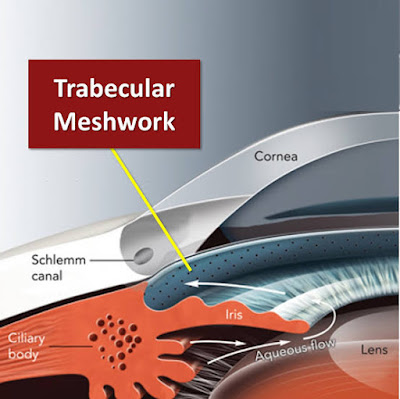*it containing low protein concentration.
*it is secreted from the ciliary epithelium.
*It is involved with all portion of the eye.
*the principal ocular structures concerned with it are:
- ciliary body
- posterior chamber
- anterior chamber
- angle of the anterior chamber, and
- aqueous outflow system.
*it is the site of the aqueous production.
POSTERIOR CHAMBER:-
*it contain about 0.06 ml of aqueous humour .
*the fresh formed aqueous humour from the ciliary process collected in this space.
Compartments of posterior chamber.
*it divided in to three compartments-
1- Prezonular space. it lies between the posterior surface of the iris and anterior surface of the zonular fibres.
2- Zonular space. it is bounded centrally by equator of the lens, peripherally by the ciliary processes, anteriorly by the posterior surface of anterior zonular fibres and posteriorly by anterior surface of posterior zonular fibres.
3 - Retrozonular space. it lies between the posterior surface of zonules and the peripheral part of anterior vitreous face.
ANTERIOR CHAMBER :-
*it is about 3 mm deep in the center of adults.
*it is comparatively shallow in very young children and old people.
*it contains about 0.25 ml of the aqueous humour.
*through pupil it communicates with posterior chamber.
ANGLE OF THE ANTERIOR CHAMBER:-
*it is the angle recess formed in between posterior surface of cornea and anterior surface of iris bounded from anterior to posteriorly by-
- Schwalbe's line
- Trabecular meshwork
- Sclera spur
- ciliary band
1- Schwalbe's line -
- it is formed by the prominent end of the descemet's membrane of the cornea
- it is a fine ridge seen just in front of the trabecular meshwork.
- width 50-150 µm.
2- Trabecular meshwork-
- it is seen as a band just anterior to the sclera spur.
- it has no pigment at birth .
- pigmentation acquired with age.
- it is the posterior portion of the scleral sulcus.
- it is wedge shaped circular ridge.
- it lies posterior to trabecular meshwork
- it is the most posterior part in the angel recess.
- width depend on the level of iris insertion
- wide in myopes and narrow in hypermetropes
- it appears as a grey/dark brown band.
AQUEOUS OUTFLOW SYSTEM:-
it includes the -
- Trabecular meshwork
- Schlemm's canal
- Collector channels
- Aqueous veins
- Episcleral veins
1- Trabecular meshwork-
- it is a sieve like structure.
- aqueous leave the eye from here.
- it bridges the scleral sulcus and converts in into tube.
2- Schlemm's canal-
- it is an endothelial lined oval channel present.
- it is single channel but occasionally branches into a plexus-like system.
3- Collector channels-
- it is lined by vascular endothelium .
- they are relatively wide at their origin 60-90mm.
- no valves are present in the collector channels.
- also known as intrascleral aqueous vessels
- these intascleral aqueous vessels can be divided into two system-
- 1- Direct system
- 2- Indirect system
- most of the aqueous vessels drain in to episcleral vein.
FUNCTIONS:-
- Maintenance of intraocular pressure.
- Metabolic rate
- Optical function
- Clearing function










No comments:
Post a Comment